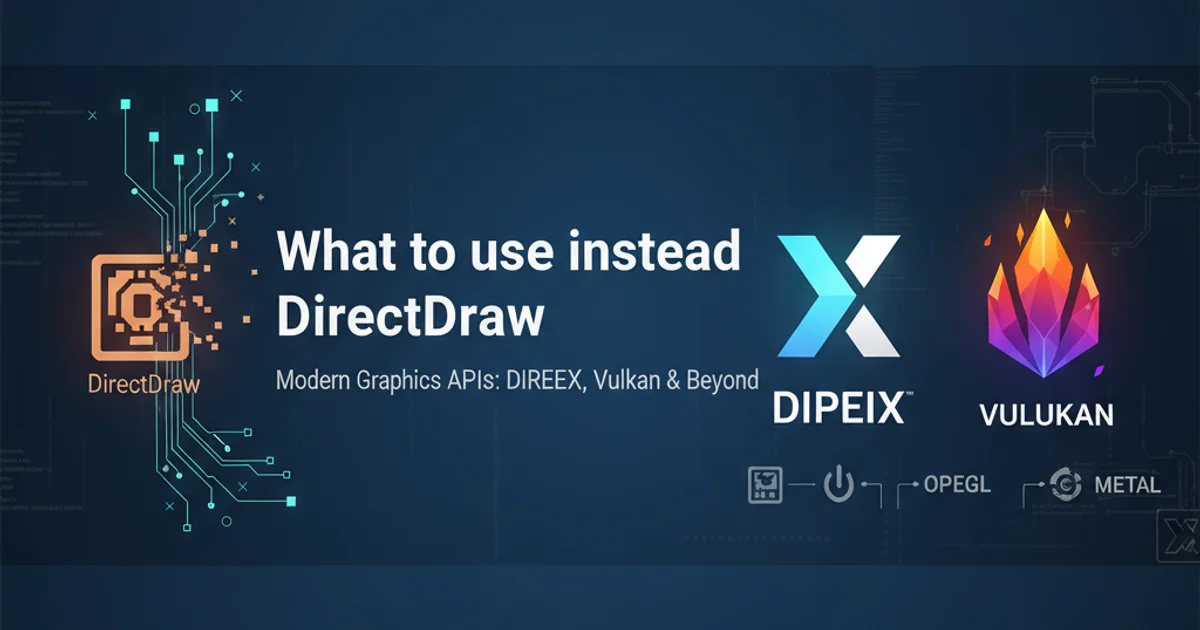What to use instead DirectDraw
Categories:
Modern Alternatives to DirectDraw for Graphics Development

Explore the evolution of graphics APIs and discover the recommended modern alternatives to the deprecated DirectDraw for 2D and 3D rendering on Windows.
DirectDraw was a foundational component of Microsoft's DirectX API suite, primarily used for hardware-accelerated 2D graphics rendering on Windows. Introduced in the mid-1990s, it provided direct access to video memory and hardware capabilities, enabling faster graphics operations than GDI (Graphics Device Interface). However, with the rapid advancement of graphics hardware and the increasing demand for sophisticated 3D rendering, DirectDraw has long been deprecated. Modern applications, whether 2D or 3D, should leverage contemporary graphics APIs that offer better performance, broader hardware support, and more robust feature sets. This article will guide you through the journey from DirectDraw to its modern successors.
The Evolution from DirectDraw
DirectDraw's primary role was to manage surfaces in video memory and provide blitting (block image transfer) capabilities. While revolutionary for its time, it lacked the advanced features required for complex 3D scenes, such as programmable shaders, sophisticated texture mapping, and efficient geometry processing. Its direct hardware access model also became problematic with increasingly complex operating systems and driver architectures. Microsoft began phasing out DirectDraw with DirectX 7 and fully deprecated it in DirectX 8, integrating its 2D functionalities into Direct3D. This shift marked a move towards a unified graphics pipeline capable of handling both 2D and 3D rendering efficiently.
flowchart TD
A[DirectDraw (Pre-DX8)] --> B{Hardware-accelerated 2D}
B --> C[Direct3D (DX8+)]
C --> D[Unified 2D/3D Rendering]
D --> E[Modern APIs (DirectX 11/12, Vulkan, OpenGL)]
style A fill:#f9f,stroke:#333,stroke-width:2px
style B fill:#bbf,stroke:#333,stroke-width:2px
style C fill:#bfb,stroke:#333,stroke-width:2px
style D fill:#fbb,stroke:#333,stroke-width:2px
style E fill:#ccf,stroke:#333,stroke-width:2pxEvolution of Graphics APIs from DirectDraw to Modern Solutions
Modern Alternatives for Windows Graphics
For any new development on Windows, several powerful graphics APIs have superseded DirectDraw. The choice depends on your specific needs, target audience, and desired level of control.
DirectX (Direct3D)
DirectX, specifically Direct3D, is the direct successor and the primary graphics API for Windows. It has evolved significantly, with DirectX 11 being a widely adopted and stable API, and DirectX 12 offering lower-level hardware access for maximum performance on modern hardware. Direct3D handles both 2D and 3D rendering by treating 2D elements as textured polygons. It provides extensive control over the rendering pipeline, including programmable shaders, advanced lighting, and complex geometry processing.
// Basic Direct3D 11 device and context creation (simplified)
#include <d3d11.h>
#include <windows.h>
// Global variables for device and context
ID3D11Device* g_pd3dDevice = nullptr;
ID3D11DeviceContext* g_pd3dContext = nullptr;
HRESULT CreateDeviceD3D(HWND hWnd)
{
// Define feature levels to attempt
D3D_FEATURE_LEVEL featureLevels[] =
{
D3D_FEATURE_LEVEL_11_0,
D3D_FEATURE_LEVEL_10_1,
D3D_FEATURE_LEVEL_10_0,
};
UINT numFeatureLevels = ARRAYSIZE(featureLevels);
// Create D3D11 device and context
HRESULT hr = D3D11CreateDevice(
nullptr, // Specify nullptr to use the default adapter
D3D_DRIVER_TYPE_HARDWARE, // Use hardware rendering
nullptr, // No software device
0, // No flags
featureLevels, // Array of feature levels
numFeatureLevels, // Number of feature levels
D3D11_SDK_VERSION, // SDK version
&g_pd3dDevice, // Pointer to the device object
nullptr, // Pointer to the feature level actually used
&g_pd3dContext // Pointer to the device context object
);
if (FAILED(hr))
return hr;
return S_OK;
}
// Call this to clean up
void CleanupDeviceD3D()
{
if (g_pd3dContext) g_pd3dContext->Release();
if (g_pd3dDevice) g_pd3dDevice->Release();
g_pd3dContext = nullptr;
g_pd3dDevice = nullptr;
}
Simplified C++ example of initializing a Direct3D 11 device and context.
Other Modern Graphics APIs
Beyond DirectX, several other powerful APIs are available, each with its own strengths:
Vulkan
Vulkan is a low-overhead, cross-platform 3D graphics and compute API. It provides direct control over the GPU, similar to DirectX 12, allowing for highly optimized rendering. It's ideal for high-performance applications and games that require fine-grained control over hardware. Its explicit nature means a steeper learning curve but offers unparalleled performance potential.
OpenGL
OpenGL is a long-standing, cross-platform graphics API. While it has a higher-level abstraction than Vulkan or DirectX 12, it remains a powerful choice for 2D and 3D graphics, especially for cross-platform applications. Modern OpenGL (Core Profile) has evolved to be more pipeline-oriented, moving away from its immediate mode legacy.
Direct2D/DirectWrite
For purely 2D graphics and high-quality text rendering on Windows, Direct2D and DirectWrite are excellent choices. They are built on top of Direct3D and provide hardware-accelerated 2D primitives, anti-aliased text, and vector graphics capabilities, making them ideal for UI development, document rendering, and other 2D-centric applications.
Choosing the Right API
The decision of which API to use depends heavily on your project's requirements:
- Windows-only, high-performance 3D games/applications: DirectX 12 (for bleeding-edge performance) or DirectX 11 (for broader compatibility and slightly easier development).
- Cross-platform, high-performance 3D games/applications: Vulkan.
- Cross-platform, general-purpose 3D/2D applications: OpenGL.
- Windows-only, 2D applications, UI, text rendering: Direct2D/DirectWrite.
- Game Engines (Unity, Unreal Engine): These engines abstract away the underlying graphics API, allowing you to focus on game logic. They typically use DirectX on Windows, Metal on macOS/iOS, and Vulkan/OpenGL on other platforms.
1. Assess Project Needs
Determine if your project requires 2D, 3D, or both. Consider performance targets, target operating systems, and developer expertise.
2. Evaluate API Features
Research the specific features and capabilities of each API (e.g., shader model support, compute capabilities, debugging tools).
3. Consider Learning Curve
Factor in the complexity and learning curve of each API. DirectX 11 and OpenGL are generally easier to start with than DirectX 12 or Vulkan.
4. Prototype and Test
If unsure, create small prototypes using different APIs to evaluate their suitability for your specific use case.